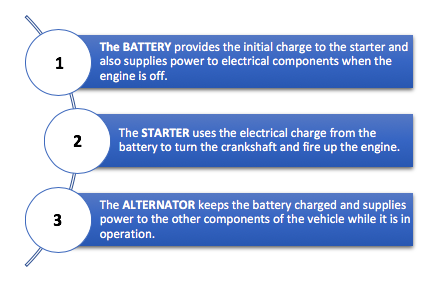

You probably never put a lot of thought into what happens when you turn your key in the ignition or hit the starter button of your car. Most of us just assume the vehicle will start and we can be on our way. However, when something goes wrong with the electrical system of our vehicle, we may not be able to get the car started or keep it going for long.
Your vehicle’s electrical system is made up of many components but the three main ones are the battery, starter, and the alternator. How these work in conjunction to make your vehicle work is a briefly illustrated below in three stages.
How Your Vehicle’s Electrical System Works

A problem at any stage of your vehicle’s electrical system can easily result in a major malfunction that will prevent your vehicle or important components from proper functioning.
Let’s review the more common problems that may arise with each stage of the electrical system.
The Battery
The battery is the primary source for electricity in starting your vehicle and running the electrical components of your car. The average life for a vehicle battery is about four to five years. Battery life can be extended through proper ongoing maintenance.
Bad battery symptoms:
Dead battery; nothing happens when you turn the ignition or hit the starter button
If you have ever left your headlights on or another electrical component by mistake, you may have experienced a “dead” battery that required a jump start. A jump start merely recharges a battery that has been drained of power.
Battery terminals and cables can become corroded or dirty over time, as a result of climate and engine dirt
If a battery is unable to recharge on its own resulting in a frequent need to jump start, it may need to be replaced
The Starter
The starter in your vehicle is a mechanism that rotates the internal combustion engine to initiate vehicle power on its own. The starter is dependent on the battery to supply the initial charge that turns the crankshaft.
Bad starter symptoms:
If it takes a long time to turn over your vehicle and it cranks slowly or is labored, this is an early sign of starter problems.
If you hear a click or a series of clicks when trying to start your vehicle but nothing else happens, you may need to have your starter solenoid (electromagnet) repaired or replaced.
The Alternator
The vehicle alternator is a type of “on-board” electrical generator. It functions during the operation of your vehicle to continuously recharge your vehicle battery as well as supply the other electrical components of the vehicle. The alternator basically takes over the power control once from the battery once the vehicle is started and the engine is running.
Bad alternator symptoms:
If you notice your headlights or dashboard lighting is dim or flickering, this is an early sign that you have alternator problems.
Engine check light is displayed
Odd noises like squealing, which can be a result of a worn or stretched serpentine belt
Inability to power down/up windows, or use electric seat controls
Your vehicle’s electrical system is critical to the car’s operation. Fortunately, the electrical system provides us with many different signs and symptoms that can alert us to a problem. If you are experiencing any of the issues noted above, contact our auto repair shop in Staten Island today for an appointment to have your electrical system inspected and/or repaired.
